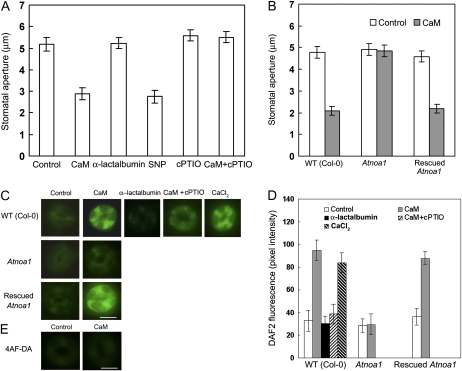Figure 1.
AtNOA1-dependent NO production regulates ExtCaM-induced stomatal closure. A, Open stomata in the wild type (WT) were incubated in MES buffer (control), 10−8 m CaM, 10−8 m α-lactalbumin, 60 μm SNP, 200 μm cPTIO, or 10−8 m CaM plus 200 μm cPTIO. B, Open stomata in the wild type, Atnoa1, and rescued Atnoa1 were incubated in MES buffer (control) or 10−8 m CaM. Stomatal apertures were measured 2 h after treatment. C and D, ExtCaM induces a NO increase in guard cells in the wild type and rescued Atnoa1 but fails in the Atnoa1 mutant. Open stomata in each genotype were incubated in 10 μm DAF2-DA buffer for 15 min and then incubated in MES buffer (control), 10−8 m α-lactalbumin, 1 mm CaCl2, 10−8 m CaM, or 10−8 m CaM plus 200 μm cPTIO for 30 min in darkness. Fluorescence images and intensities in guard cells were recorded and are shown in C and D, respectively. E, Open stomata in the wild type were incubated in 10 μm 4AF-DA, a negative control of DAF2-DA, for 15 min and then incubated in MES buffer or 10−8 m CaM for 30 min in darkness, and fluorescence images in guard cells were recorded. Bars = 10 μm.

